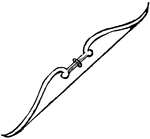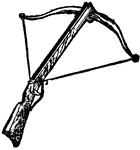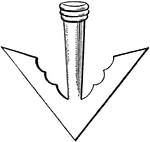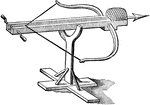Archery
The Archery ClipArt gallery offers 26 illustrations of weapons and ammunition for ranged weapons used in military known as archery, such as the bow and crossbow.

Arbalister
"One armed with the arbalist; a crossbowman; especially, a soldier carrying the arbalist of war."-Whitney,…

Ancient bows
"Represents two forms of the bow; the upper, the Scythian or Parthian bow enstrung, agreeing with the…

A Chariot of Iron
A horse-drawn chariot for soldiers, used to break enemy battalions. The wheels are equipped with blades…

Cross-Bow
A cross-bow is in effect nothing more nor less than an ordinary bow set crosswise in a butt in shape…

French Crossbow
A missive weapon formed by a bow fixed athwart a stock in which there is a groove or barrel to direct…
Fire Arrows of the 14th and 15th Centuries
"Fire-arrows, 14th and 15th centuries. An arrow formerly used, whether shot from a hand-bow or from…














